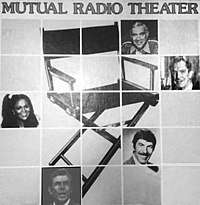Sears Radio Theater

Sears Radio Theater was a radio drama anthology series which ran weeknights on CBS Radio in 1979, sponsored by the Sears chain. Often paired with The CBS Radio Mystery Theater during its first season, the program offered a different genre of drama for each evening's broadcast.
In January 1980, the program moved to the Mutual Broadcasting System and became the Mutual Radio Theater. The Mutual series broadcast repeats from the CBS run until September 1980, when a short season of new dramas was presented. Sears continued as a sponsor during the Mutual run. The program turned out to be Mutual's final radio drama series. Mutual continued to broadcast repeats of the program (along with a few previously unaired episodes) until December 1981.
Monday was "Western Night" and was hosted by Lorne Greene. Tuesday was "Comedy Night", hosted by Andy Griffith. Wednesday was "Mystery Night" with Vincent Price as host. Thursday was "Love and Hate Night" with Cicely Tyson doing honors as host. Finally, Friday brought "Adventure Night", first hosted by Richard Widmark and later by Howard Duff and then by Leonard Nimoy.
Actors heard on the series included Jim Jordan, Henry Morgan, Daws Butler, June Foray, Parley Baer, Mary Jane Croft, Howard Culver, John Dehner, Joan McCall, Ron Stark, Don Diamond, Virginia Gregg, Janet Waldo, Vic Perrin, Hans Conried, Marvin Miller, Elliott Lewis, Jeff Corey, Lesley Woods, Robert Rockwell, Lurene Tuttle, Eve Arden, Keith Andes, Harriet Nelson, Alan Young, Tom Bosley, Marion Ross, Lloyd Bochner, Rick Jason, Frank Campanella, Toni Tennille, Arthur Hill, Dan O'Herlihy, Jesse White and Frank Nelson.[1] Actress Peggy Webber was heard on 52 episodes.
It was produced and directed by Fletcher Markle and Elliott Lewis. The theme was composed and conducted by Nelson Riddle.[1]
Though less long-lived than NPR's Earplay or the CBS Radio Mystery Theater, it was an ambitious attempt to reinvigorate a neglected field. Like Earplay, it was broadcast in stereo.
References
- 1 2 Dunning, John (1998). On the Air: The Encyclopedia of Old-Time Radio. Oxford University Press. p. 603.